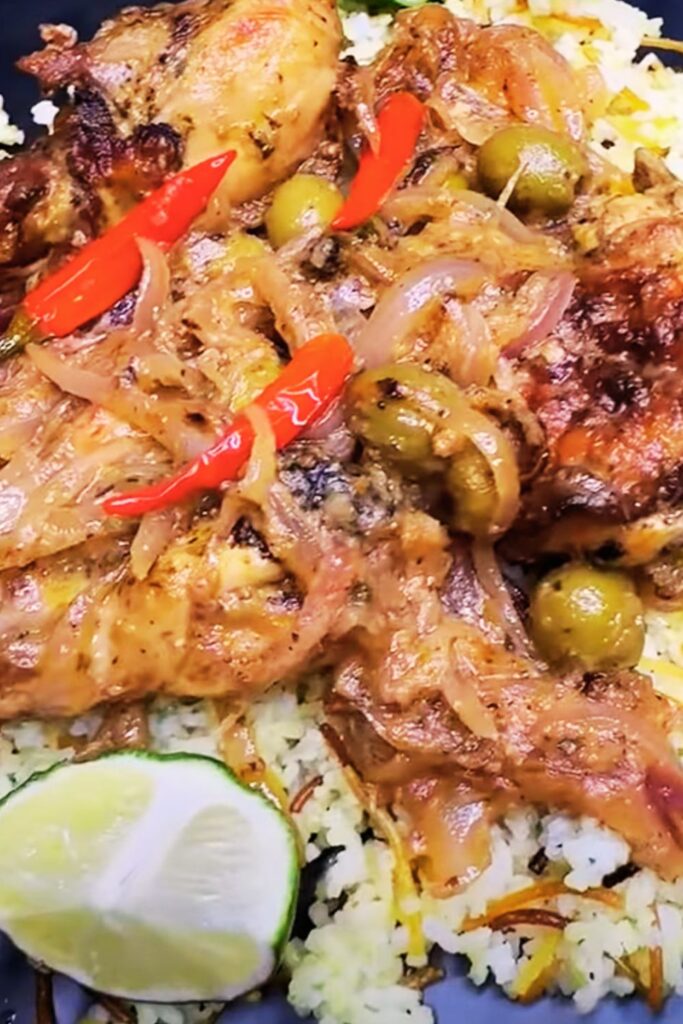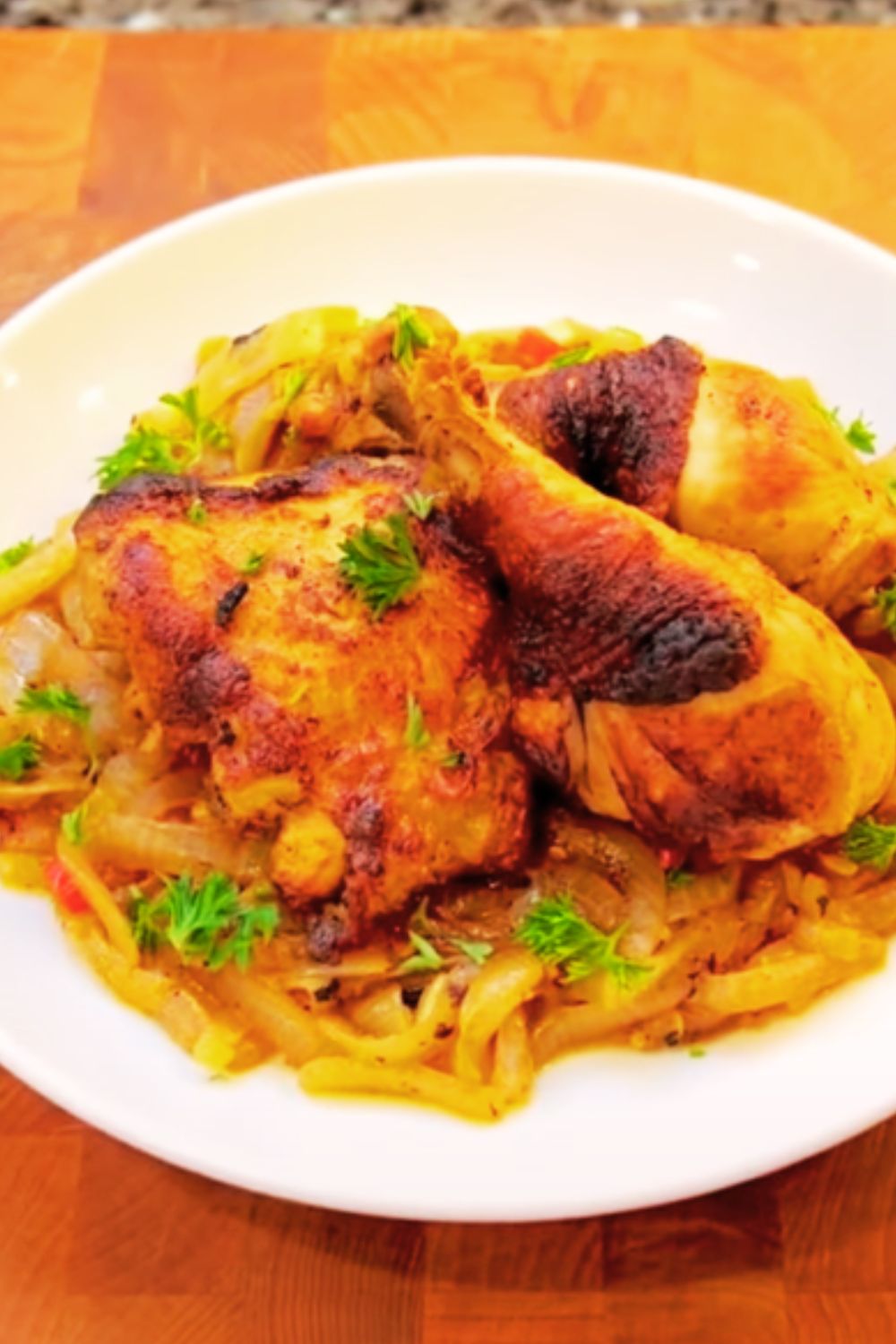There’s something magical about discovering a dish that transports you to faraway lands with just one bite. That’s exactly what happened the first time I tried Poulet Yassa, a mouthwatering Senegalese chicken dish that has since become a regular feature in my kitchen. This iconic West African recipe combines the sharp tanginess of lemons, the sweetness of caramelized onions, and the subtle heat of chili peppers to create a flavor profile that’s both complex and comforting.
What makes Poulet Yassa truly special isn’t just its incredible taste, but also its cultural significance. As one of Senegal’s national dishes, it represents the rich culinary heritage of West Africa and tells a story of cultural exchange, resourcefulness, and celebration. Today, I’m excited to share my tried-and-tested recipe for authentic Poulet Yassa, along with some personal tips I’ve picked up along the way.
The Cultural Significance of Poulet Yassa
Before we dive into the cooking process, I think it’s worth taking a moment to appreciate the cultural context of this beloved dish. Poulet Yassa originated in the Casamance region of southern Senegal, an area known for its lush landscapes and vibrant food culture.
In Senegalese tradition, Yassa is often prepared for special occasions and family gatherings. The slow marination process and lengthy cooking time make it a labor of love, typically reserved for celebrations. The dish beautifully represents the fusion of indigenous West African cooking techniques with influences from French colonial history and the abundance of citrus fruits introduced through trade routes.
What I find most fascinating about Poulet Yassa is how it has evolved over time while maintaining its core identity. Each family has their own slight variation, passed down through generations. Some add mustard for extra tang, others incorporate different vegetables, but the essence remains the same: marinated chicken paired with plenty of caramelized onions and a bright, tangy sauce.
Ingredients for Authentic Poulet Yassa
One of the joys of making Poulet Yassa is that it doesn’t require exotic or hard-to-find ingredients. Most of what you’ll need is probably already in your pantry or easily available at your local grocery store.
For 4-6 servings, you’ll need:
- 2-3 pounds (about 1-1.5 kg) chicken pieces (traditionally a whole chicken cut into pieces, but I often use thighs and drumsticks)
- 6-8 large onions, thinly sliced (yes, really that many!)
- 8-10 tablespoons fresh lemon juice (about 4-5 lemons)
- 1/4 cup vegetable or peanut oil, plus extra for frying
- 4-5 garlic cloves, minced
- 1-2 habanero or Scotch bonnet peppers, minced (adjust to your heat preference)
- 2 tablespoons Dijon mustard
- 2 bay leaves
- 1 tablespoon fresh thyme leaves (or 1 teaspoon dried)
- 2 cups chicken stock
- Salt and freshly ground black pepper to taste
- 2-3 tablespoons pitted olives (optional, but traditional)
- Cooked rice for serving (preferably long-grain)
Equipment You’ll Need
DL: Marinating Container : A large glass or plastic container with a lid for marinating the chicken overnight.
DL: Heavy-bottomed Pot : A Dutch oven or similar heavy pot works best for caramelizing the onions and creating the sauce.
DL: Sharp Knife : For slicing the mountain of onions this recipe requires.
DL: Wooden Spoon : For stirring without scratching your cookware during the long caramelization process.
The Secret to Perfect Poulet Yassa: Marination
If there’s one thing I’ve learned from making Poulet Yassa countless times, it’s that the marination process is absolutely crucial. This isn’t a dish to rush – the extended marination time allows the acids from the lemon juice to tenderize the chicken while infusing it with incredible flavor.
Marination Process
- Begin by preparing your chicken. If using a whole chicken, cut it into 8-10 pieces. I prefer to leave the skin on for flavor, but you can remove it if you prefer a lighter dish.
- In a large bowl, combine the sliced onions, minced garlic, chopped chilies, Dijon mustard, bay leaves, thyme, lemon juice, 1/4 cup oil, salt, and pepper.
- Add the chicken pieces to this mixture, making sure each piece is well-coated. Use your hands (with gloves if you’re working with hot peppers) to massage the marinade into the chicken.
- Cover the bowl and refrigerate for at least 4 hours, but preferably overnight (or even up to 24 hours). The longer the marination, the more flavorful your Poulet Yassa will be.
- Occasionally turn the chicken in the marinade to ensure even flavor distribution.

Cooking Poulet Yassa: A Step-by-Step Guide
After your chicken has marinated to perfection, it’s time to transform these simple ingredients into a magnificent meal. The cooking process involves several steps, each contributing to the complex layers of flavor that make Poulet Yassa so special.
Step 1: Separate and Prepare the Components
- Remove the chicken from the marinade, shaking off excess onions.
- Strain the onions from the marinade liquid, reserving both separately.
- Pat the chicken pieces dry with paper towels (this helps them brown better).
Step 2: Brown the Chicken
- Heat 2-3 tablespoons of oil in a large, heavy-bottomed pot or Dutch oven over medium-high heat.
- Working in batches to avoid crowding, brown the chicken pieces on all sides (about 3-4 minutes per side).
- The goal here isn’t to cook the chicken through, but to develop a nice golden crust. The chicken will finish cooking in the sauce later.
- Once browned, transfer the chicken to a plate and set aside.
Step 3: Caramelize the Onions
This is perhaps the most crucial step in achieving authentic Poulet Yassa flavor:
- In the same pot (no need to clean it), add the strained onions with a pinch of salt.
- Reduce heat to medium-low and cook slowly, stirring occasionally, for about 25-30 minutes until the onions are deeply caramelized to a rich golden-brown color.
- Be patient here – properly caramelized onions are the heart and soul of this dish.
- If the onions start to stick or brown too quickly, add a splash of water and scrape up any browned bits from the bottom of the pot.
Step 4: Create the Sauce
- Once the onions are caramelized, pour in the reserved marinade liquid and chicken stock.
- Bring to a gentle simmer, then taste and adjust seasoning if necessary.
- Add the bay leaves from the marinade.
- If using olives, add them at this stage.
Step 5: Return the Chicken and Finish Cooking
- Return the browned chicken pieces to the pot, nestling them into the onion sauce.
- Reduce heat to low, cover, and simmer for about 30-45 minutes, or until the chicken is completely tender and cooked through.
- Occasionally spoon the sauce over the chicken pieces to baste them.

Serving Suggestions
Traditional Poulet Yassa is typically served over a bed of fluffy white rice, which provides the perfect canvas for soaking up the delicious onion sauce. Here are some serving ideas to complete your Senegalese feast:
- Arrange the chicken pieces over white rice on a serving platter, then generously spoon the onion sauce over the top.
- Garnish with fresh herbs like parsley or cilantro for a pop of color.
- Serve with a side of plantains – either fried ripe plantains (alloco) for sweetness or boiled green plantains for a starchier complement.
- Include a fresh vegetable side like a simple cucumber and tomato salad dressed with lemon juice and olive oil.
- A side of fresh fruit, particularly pineapple or mango, provides a refreshing counterpoint to the tangy chicken.
Nutritional Value of Poulet Yassa
Not only is Poulet Yassa absolutely delicious, but it also offers a good nutritional balance. Here’s a breakdown of the approximate nutritional content per serving (without rice):
| Nutrient | Amount per Serving | % Daily Value* |
|---|---|---|
| Calories | 420-450 kcal | 21-23% |
| Protein | 35-40g | 70-80% |
| Fat | 24-28g | 31-36% |
| Carbohydrates | 15-18g | 5-6% |
| Fiber | 3-4g | 11-14% |
| Vitamin C | 45-50mg | 50-56% |
| Iron | 2.5-3mg | 14-17% |
| Potassium | 600-650mg | 13-14% |
*Based on a 2,000 calorie diet
The high protein content comes from the chicken, while the abundant onions provide fiber, vitamins, and minerals. The lemon juice adds a significant dose of vitamin C, making this dish not only tasty but also nutritionally valuable.
Variations and Adaptations
While I love traditional Poulet Yassa, I’ve also enjoyed experimenting with different variations over the years. Here are some adaptations you might want to try:
Poulet Yassa with Mustard
Many modern versions include Dijon mustard in the marinade for an extra layer of flavor. Start with 1-2 tablespoons and adjust to your taste.
Fish Yassa (Yassa Au Poisson)
Substitute firm white fish like snapper or grouper for the chicken. The cooking time will be much shorter – the fish will only need about 10-15 minutes in the sauce.
Vegetarian Yassa
Replace the chicken with hearty vegetables like eggplant, cauliflower, and carrots, or with firm tofu. Vegetable broth can substitute for chicken stock.
Grilled Yassa
In parts of Senegal, the marinated chicken is grilled over charcoal before being added to the onion sauce, adding a wonderful smoky dimension to the dish. If you have a grill, this is definitely worth trying!
Troubleshooting Common Issues
As with any recipe, sometimes things don’t go quite as planned. Here are solutions to some common Poulet Yassa challenges:
Sauce Too Thin
If your sauce ends up too watery, remove the chicken pieces and simmer the sauce uncovered for 10-15 minutes to reduce and thicken it.
Sauce Too Sour
The tanginess of Poulet Yassa is part of its charm, but if it’s too sour for your taste, you can balance it by adding:
- A teaspoon of honey or sugar
- A little more mustard
- An extra tablespoon of oil
Chicken Not Tender Enough
If your chicken isn’t falling-off-the-bone tender after the recommended cooking time, simply continue simmering for another 15-20 minutes. The acid in the lemon juice should eventually break down even the toughest cuts.

Storage and Reheating Tips
One of the wonderful things about Poulet Yassa is that it actually tastes even better the next day, as the flavors have more time to meld. Here’s how to store and reheat your leftovers:
Storage
- Refrigerate leftovers in an airtight container for up to 3 days.
- For longer storage, Poulet Yassa freezes well for up to 3 months. I recommend removing the chicken bones before freezing for easier reheating.
Reheating
- Gently reheat on the stovetop over medium-low heat, adding a splash of water or chicken stock if the sauce has thickened too much.
- If reheating from frozen, thaw overnight in the refrigerator before reheating.
- Avoid microwaving if possible, as it can make the chicken tough, but if you must, use a lower power setting and cover with a damp paper towel.
My Personal Journey with Poulet Yassa
I first discovered Poulet Yassa during a cooking class I took while visiting Morocco. Though it’s a Senegalese dish, our instructor had lived in Dakar for several years and shared this recipe as one of her favorites. I was immediately captivated by the bright, complex flavors and the way such simple ingredients could transform into something extraordinary.
When I returned home, I began experimenting with the recipe, tweaking it slightly each time. I remember the first time I served it to friends – their eyes widened with the first bite, and they immediately asked for the recipe. Since then, it’s become one of my signature dishes for dinner parties and special occasions.
What I love most about Poulet Yassa is how it brings people together. There’s something inherently communal about a dish that takes time and care to prepare, and the resulting flavors feel like a celebration. Every time I make it, I feel connected not only to those I’m sharing it with but also to the rich culinary tradition from which it comes.
Frequently Asked Questions
Can I use boneless chicken for Poulet Yassa? Yes, you can use boneless chicken thighs or breasts, though bone-in pieces typically provide more flavor. If using boneless cuts, reduce the simmering time to about 20-25 minutes to prevent the chicken from becoming dry.
Is Poulet Yassa very spicy? The spice level is entirely adjustable. Traditional Yassa uses Scotch bonnet or habanero peppers, which can be quite hot. You can control the heat by removing the seeds and membrane from the peppers, using less spicy varieties like jalapeños, or omitting the peppers altogether for a mild version.
Can I make Poulet Yassa ahead of time for a party? Absolutely! In fact, I recommend it. Make the dish a day ahead, refrigerate, and reheat gently before serving. The flavors actually improve with time, making this an ideal make-ahead dish for entertaining.
What type of onions work best for this recipe? Yellow onions are ideal as they caramelize beautifully, but white onions will also work. Red onions can be used in a pinch, though they’ll give the dish a slightly different flavor and color.
Can I use bottled lemon juice instead of fresh? While fresh lemon juice provides the best flavor, bottled lemon juice can work as a substitute when fresh lemons aren’t available. Just be aware that the flavor won’t be quite as bright and complex.
How can I make this dish less acidic? If you’re sensitive to acidic foods, you can reduce the amount of lemon juice and increase the amount of mustard and oil in the marinade. Adding a touch of honey or sugar to the sauce can also help balance the acidity.
Bringing Senegal to Your Kitchen
Cooking dishes from other cultures is one of my favorite ways to travel without leaving home. When I make Poulet Yassa, my kitchen fills with aromas that transport me straight to the vibrant streets of Dakar. There’s something deeply satisfying about connecting with another culture through its food, especially when the recipe has been honed over generations.
What makes Poulet Yassa particularly special is how accessible it is. You don’t need specialty ingredients or advanced cooking techniques – just patience, good ingredients, and respect for the process. The long marination and slow cooking teach us to slow down and appreciate the transformation of simple components into something greater than the sum of its parts.
I encourage you to approach this recipe not just as instructions to follow, but as an opportunity to experience a piece of Senegalese culture. Notice how the chicken tenderizes in the acidic marinade, how the onions gradually transform from sharp and pungent to sweet and mellow, how the sauce thickens and intensifies. These are the small miracles of cooking that connect us to our food and to each other.
Whether you’re cooking for your family on a weeknight or hosting friends for a special dinner, Poulet Yassa offers a delicious departure from the ordinary. It’s a dish that invites conversation, encourages lingering at the table, and leaves everyone feeling nourished in body and spirit.
So gather your ingredients, set aside some time, and prepare to fall in love with this Senegalese classic. I promise your taste buds – and your dinner guests – will thank you.



